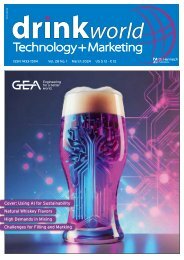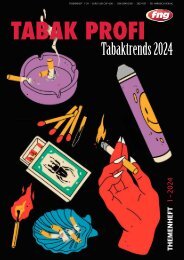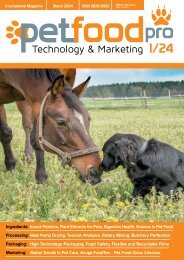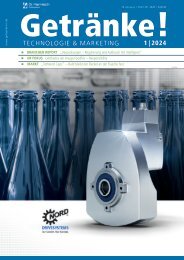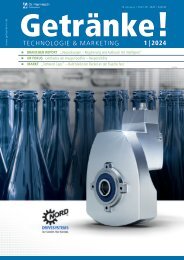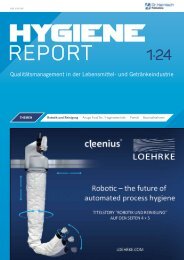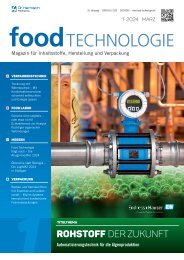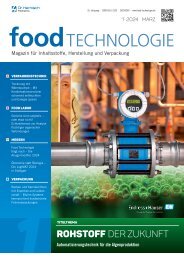petfood pro 3/2022
PetFood PRO is the international magazine for executives and specialists in the manufacture of food for domestic animals – the pet food industry. The magazine focuses on food and delicacies for dogs, cats and other small animals, ornamental birds and fish, as well as animals kept in terrariums. We publish feature articles, reports and announcements about new ingredients, technology, equipment and processes, packaging machinery and materials as well as marketing trends and developments. Readers are executives, product developers and specialists in the pet food industry, including process and packaging engineers. PetFood PRO will be published in English. Circulation is worldwide, with an emphasis on important growth markets.
PetFood PRO is the international magazine for executives and specialists in the manufacture of food for domestic animals – the pet food industry. The magazine focuses on food and delicacies for dogs, cats and other small animals, ornamental birds and fish, as well as animals kept in terrariums.
We publish feature articles, reports and announcements about new ingredients, technology, equipment and processes, packaging machinery and materials as well as marketing trends and developments. Readers are executives, product developers and specialists in the pet food industry, including process and packaging engineers. PetFood PRO will be published in English. Circulation is worldwide, with an emphasis on important growth markets.
Create successful ePaper yourself
Turn your PDF publications into a flip-book with our unique Google optimized e-Paper software.
PROCESSING<br />
How Continuous Food<br />
Processing Equipment Holds<br />
The Secret To Better Pet Food<br />
Continuous naturalness in wet pet food<br />
People love to treat their pets to the best,<br />
so the demand for high quality pet food at<br />
a reasonable price continues to rise. A big<br />
challenge is to maintain consistency with<br />
large <strong>pro</strong>duction volume while achieving<br />
shortest possible <strong>pro</strong>cessing times – and<br />
to create a nutritious <strong>pro</strong>duct at the same<br />
time. Valuable nutrients and <strong>pro</strong>teins from<br />
meat, fish, vegetables and cereals ideally<br />
remain unchanged during <strong>pro</strong>cessing<br />
so that the <strong>pro</strong>duct can meet the high<br />
demands of animals and their owners.<br />
Common Challenges In Pet Food<br />
Production<br />
Many factors can jeopardize consistency<br />
and quality – both within a single batch<br />
and between batches. Slow ineffective,<br />
or over, heating causing inefficient use<br />
of ingredients, degradation of <strong>pro</strong>teins<br />
and deviations in the <strong>pro</strong>duct quality.<br />
In contrast to typical batch and retort<br />
cooking, the RotaTherm® heats the <strong>pro</strong>duct<br />
rapidly, but gently, in a continuous <strong>pro</strong>cess<br />
within seconds only to the required<br />
temperature using priority direct steam<br />
injection technology and thus offers<br />
many advantages, like original colour of<br />
<strong>pro</strong>duct, unchanged shape of particulates,<br />
low denaturation of <strong>pro</strong>teins, minimized<br />
waste, <strong>pro</strong>duction breaks, utilities and<br />
cleaning chemicals. You benefit from<br />
more efficient, more <strong>pro</strong>ductive and costeffective<br />
manufacturing, your customer<br />
from a more nutritious and consistent<br />
<strong>pro</strong>duct.<br />
Consistency<br />
As with most <strong>pro</strong>cessed food, maintaining<br />
consistency across large <strong>pro</strong>duction<br />
volumes can be challenging. This becomes<br />
an even bigger <strong>pro</strong>blem if batch cooking<br />
<strong>pro</strong>cess is in use. With batch cooking,<br />
you waste a substantial amount of time<br />
to <strong>pro</strong>cess each batch, often having to<br />
wait to fill from a large buffer tank. This<br />
stag ing, with varying dwell times before<br />
filling can magnify inconsistencies,<br />
leading to temperature loss and changes<br />
in pressure, moisture, color and texture,<br />
further overcooking without necessarily<br />
hydrating.<br />
Each of the issues above poses a threat<br />
to consistency, within a single batch and<br />
in between batches, leading to a lowerquality,<br />
less consistent <strong>pro</strong>duct. With end<br />
customers willing to pay a premium for<br />
quality pet food, this is the last thing you<br />
want to happen! Inconsistencies alone<br />
may not be the biggest concern, but they<br />
are the source of inefficient ingredient<br />
usage and end <strong>pro</strong>duct variation.<br />
Most pet food recipes combine several<br />
different ingredients including meat,<br />
vegetables, grains, stabilizers, by-<strong>pro</strong>ducts,<br />
etc. Each of these have different levels of<br />
viscosity and chunkiness, and different<br />
requirements, therefore demanding<br />
specific optimal cooking conditions to<br />
guarantee a consistent texture – every<br />
minute, hour and week of <strong>pro</strong>duction.<br />
Consistency is directly related to your<br />
market growth because it keeps your<br />
customers coming back.<br />
Production Volumes<br />
As part of the fast-moving consumer goods<br />
industry, pet food is generally sold at low<br />
<strong>pro</strong>fit margins, so high <strong>pro</strong>duction and<br />
sales volume are key to long-term survival<br />
and a successful pet food business. With<br />
batch <strong>pro</strong>cessing, gaps in <strong>pro</strong>duction are<br />
often a part of daily operations. The batch<br />
<strong>pro</strong>cess is more time consuming, with time<br />
allocated for preparing each batch, mixing<br />
the ingredients, heating the formulation,<br />
adjusting settings, waiting to fill before<br />
starting the next batch and rinsing.<br />
Each of these steps negatively impact<br />
your efficiency and <strong>pro</strong>ductivity as they<br />
are done in series not parallel. Much of<br />
your time is consumed performing nonvalue-adding<br />
tasks, instead of <strong>pro</strong>ducing<br />
pet food, limiting the <strong>pro</strong>duction volumes<br />
your business strives to achieve.<br />
Quality<br />
Many recipes use a variety of different<br />
ingredients – yours might combine<br />
vegetables, meat and fish, as well as<br />
powders, by-<strong>pro</strong>ducts and grains. As<br />
we mentioned above, temperature,<br />
moisture and pressure fluctuate between<br />
batches, affecting the final composition<br />
and causing unpredictable ingredient<br />
usage. Denaturation of the <strong>pro</strong>teins is the<br />
result of long heating <strong>pro</strong>cesses and the<br />
naturalness of the <strong>pro</strong>ducts is no longer<br />
guaranteed.<br />
After cooking, a defined holding time<br />
ensures the relevant bacteria killing to<br />
be able to offer the final <strong>pro</strong>duct with a<br />
perfect shelf life. A hot fill <strong>pro</strong>cess into<br />
cans, casings or trays will help to keep<br />
the <strong>pro</strong>duct safe and <strong>pro</strong>tects against<br />
recontamination. ‘Post filling’ cooling can<br />
be done in a flexible way with a spiral cooler,<br />
waterbath or cooling tunnel. Continuous<br />
22<br />
Technology & Marketing











